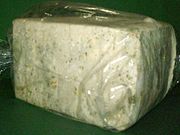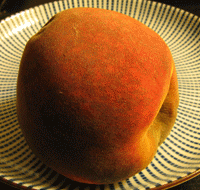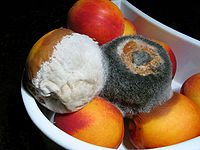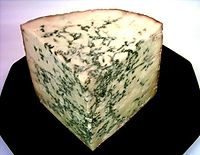
Mold
Background Information
This Schools selection was originally chosen by SOS Children for schools in the developing world without internet access. It is available as a intranet download. See http://www.soschildren.org/sponsor-a-child to find out about child sponsorship.
Moulds (or molds, see spelling differences) include all species of microscopic fungi that grow in the form of multicellular filaments, called hyphae. In contrast, microscopic fungi that grow as single cells are called yeasts. A connected network of these tubular branching hyphae has multiple, genetically identical nuclei and is considered a single organism, referred to as a colony or in more technical terms a mycelium.
Molds do not form a specific taxonomic or phylogenetic grouping, but can be found in the divisions Zygomycota, Deuteromycota and Ascomycota. Although some molds cause disease or food spoilage, others are useful for their role in biodegradation or in the production of various foods, beverages, antibiotics and enzymes.
Biology
There are thousands of known species of molds, which include opportunistic pathogens, exclusive saprotrophs, aquatic species and thermophiles. Like all fungi, molds derive energy not through photosynthesis but from the organic matter on which they live. Typically, molds secrete hydrolytic enzymes, mainly from the hyphal tips. These enzymes degrade complex biopolymers such as starch, cellulose and lignin into simpler substances which can be absorbed by the hyphae. In this way, molds play a major role in causing decomposition of organic material, enabling the recycling of nutrients throughout ecosystems. Many molds also secrete mycotoxins which, together with hydrolytic enzymes, inhibit the growth of competing microorganisms.
Molds reproduce through small spores, which may contain a single nucleus or be multinucleate. Mold spores can be asexual (the products of mitosis) or sexual (the products of meiosis); many species can produce both types. Some can remain airborne indefinitely, and many are able to survive extremes of temperature and pressure.
Although molds grow on dead organic matter everywhere in nature, their presence is only visible to the unaided eye when mold colonies grow. A mold colony does not comprise discrete organisms, but an interconnected network of hyphae called a mycelium. Nutrients and in some cases organelles may be transported throughout the mycelium. In artificial environments like buildings, humidity and temperature are often stable enough to foster the growth of mold colonies, commonly seen as a downy or furry coating growing on food or surfaces.
Some molds can begin growing at temperatures as low as 2°C. When conditions do not enable growth, molds may remain alive in a dormant state, within a large range of temperatures before they die. The many different mold species vary enormously in their tolerance to temperature and humidity extremes. Certain molds can survive harsh conditions such as the snow-covered soils of Antarctica, refrigeration, highly acidic solvents, and even petroleum products such as jet fuel.
Xerophilic molds use the humidity in the air as their only water source; other molds need more moisture.
Common molds
- Acremonium
- Aspergillus
- Cladosporium
- Fusarium
- Mucor
- Neurospora
- Penicillium
- Rhizopus
- Stachybotrys
- Trichoderma
Uses
Food production
Cultured molds are used in the production of foods, including:
- cheese ( Penicillium spp.)
- tempeh ( Rhizopus oligosporus)
- Quorn ( Fusarium venenatum)
- certain black teas pu-erh
- sausages
- shoyu
The koji molds are a group of Aspergillus species, notably Aspergillus oryzae, that have been cultured in eastern Asia for many centuries. They are used to ferment a soybean and wheat mixture to make soybean paste and soy sauce. They are also used to break down the starch in rice (saccharification) in the production of sake and other distilled spirits.
Drug creation
Alexander Fleming's famous discovery of the antibiotic penicillin involved the mold Penicillium chrysogenum.
Several cholesterol-lowering drugs (such as Lovastatin, from Aspergillus terreus) are derived from molds.
The immunosuppressant drug cyclosporine, used to suppress the rejectionof transplanted organs, is derived from the mold Tolypocladium inflatum.
Other Uses
Other molds are cultivated for their ability to produce useful substances. Aspergillus niger is used in the production of citric acid, gluconic acid and many other compounds and enzymes.
The mold Aspergillus nidulans is an important model organism.
Health effects
Mold spores can be allergenic, causing irritations of eye, nose, throat, and lungs.
Molds may excrete liquids or gases; not all can be detected by smell. Some molds generate toxic liquid or gaseous compounds, called mycotoxins. Molds that produce mycotoxins are sometimes referred to as toxic molds. Of these molds, some only produce mycotoxins under specific growing conditions. Mycotoxins are harmful or lethal to humans and animals when exposure is high enough.
Dermatophytes are the parasitic fungi that cause skin infections such as Athlete's foot and Jock Itch. Most dermataphyte fungi take the form of a mold, as opposed to a yeast, with appearance (when cultured) that is similar to other molds.
Opportunistic infection by molds such as Penicillium marneffei and Aspergillus fumigatus is a common cause of illness and death among immunocompromised people, including AIDS victims.
Growth in buildings
Mold growth in buildings can lead to a variety of health issues. Various practices can be followed to mitigate mold issues in buildings, the most important of which is to reduce moisture levels that can facilitate mold growth. Removal of affected materials after the source of moisture has been reduced and/or eliminated may be necessary for remediation.
Growth in Your Home
A mold inspection in your home determines whether harmful mold is present. Exposure to bacteria and fungus in indoor air has emerged as a significant health problem in residential environments as well as in occupational settings. Molds and mildews are names given to thousands of species of filamentous fungi. The molds have clusters of spores that are located on the end of tiny stalks. The spores are the reproductive product of the mature mold.
There are molds that can grow on wood, paper, carpet, and foods. When excessive moisture or water accumulates indoors, mold growth will often occur, particularly if the moisture problem remains undiscovered or un-addressed. There is no practical way to eliminate all molds and mold spores in the indoor environment; the way to control indoor mold growth is to control moisture.





